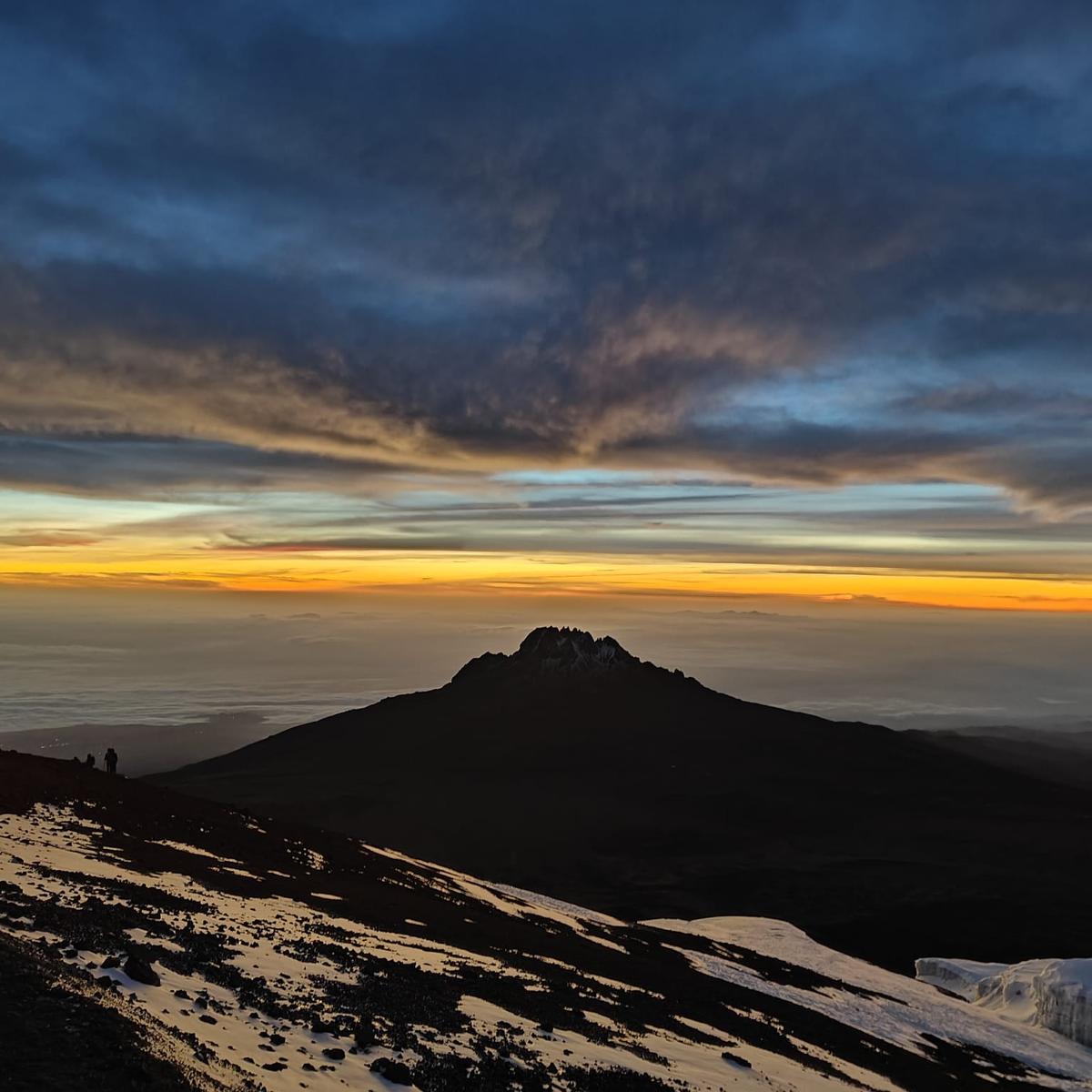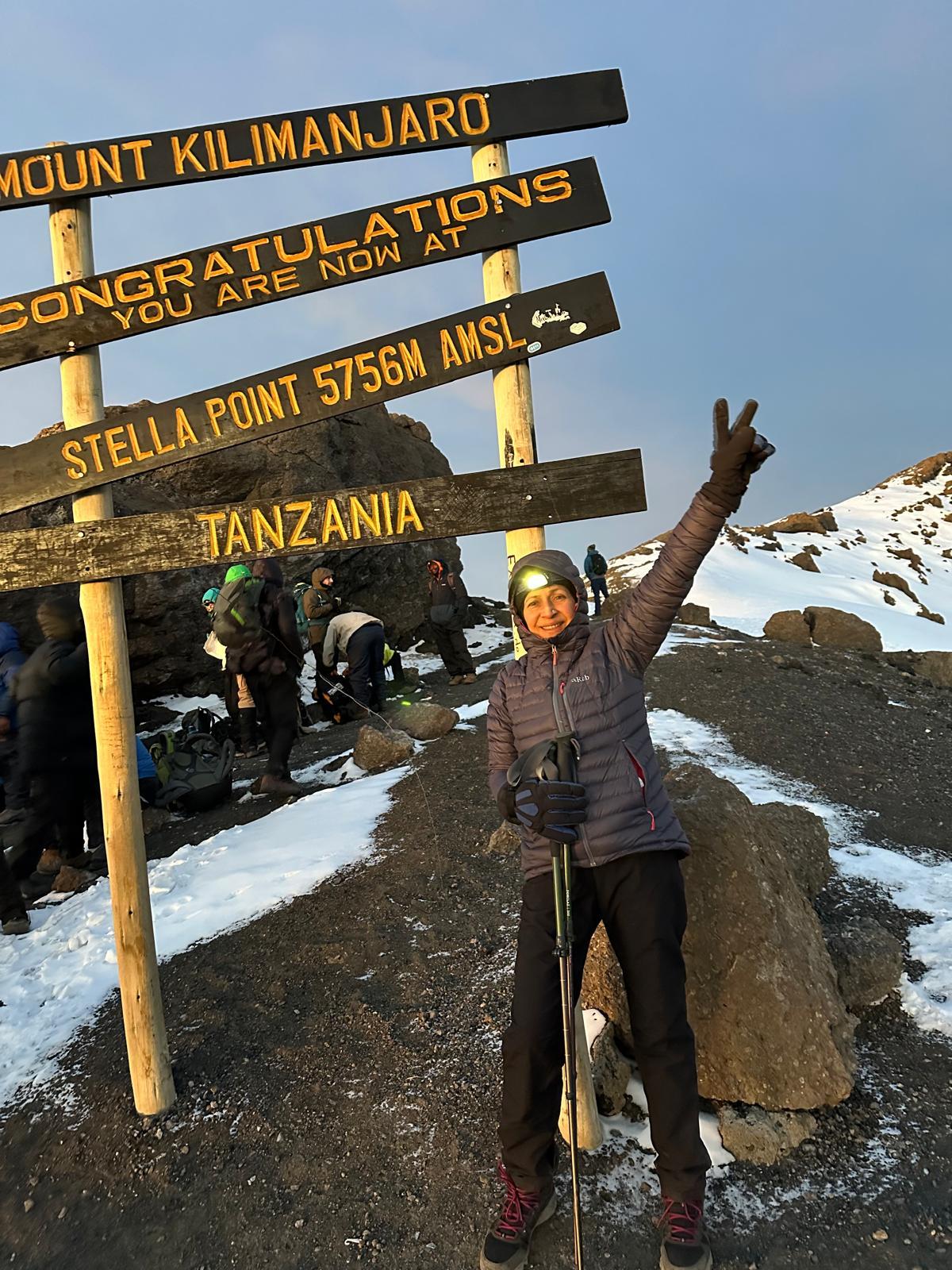I first see Kilimanjaro from the flight into Tanzania — a stunning sight as it looms above the clouds encircling it. An iconic visual.
As we enter through the little town of Moshe in Tanzania from the Kilimanjaro International Airport, I mentally prepare myself for the trek ahead. At the age of 72, I had trained hard to be able to climb this mountain. Weight training, walking with a six-kilogram weighted vest and climbing the two hills in my city at least twice a week; Tirusulam Hill and St Thomas Mount in Chennai. I also swim two kilometres twice a week. All these build resistance and give you a raised heart rate ; which is useful when you climb at an altitude.
Kilimanjaro is the highest single standing mountain in the world that is not part of a range. The summits are Stella Point at 5,756m and Uhuru Peak at 5,895m. It is also considered to be one of the Seven Summits in Seven Continents.
We are a group of 10 climbers. Six from India (Chennai and Hyderabad), two from Australia and two from Germany. We have a large support staff of 25. The leaders are Bongo and Afrikaan, whose company, Kili Worldborn Safaris is responsible for handling the logistics of the trip, including transportation, accommodation, food and trekking arrangements. There is the chief guide and his assistants, chef and kitchen staff, tent boys, toilet boys and our personal porters who walk with each of us to guide and help us along the trail. This has been arranged by Arjan Kripal Singh and his company in India, Get Up And Go!
Trekking Mount Kilimanjaro
| Photo Credit:
Vidya Gajapathi Raju Singh
We are driven to the start point at the Londorossi Gate of the Lemosho Route, which is a scenic two-day trek that goes through a rain forest. The Lemosho Route crosses the entire Shira Ridge, a plateau that goes from West to East. The climb to the summit and to the last camp takes us eight days of trekking. We have a new camp each night at designated campsites.
We usually begin at 7am and climb for about five to six hours each day. The terrain gradually changes from tropical rain forest to Arctic zone to alpine desert as the trail climbs higher. I often pause to catch my breath and soak in the stunning views, bright with exotic flowers and plants that grow in this harsh terrain.
The trek is challenging. Especially on day three, when we climb from Shira Camp to Moir Hut, and about halfway through the trek, encounter rain. This makes climbing difficult as the stones and rocks become wet and slippery. Rain water flows down the mountainsides, and besides being cold and rather wet, our shoes are drenched. My spirits are down as I climb with cumbersome rain gear on.

Vidya Gajapathi Raju Singh
| Photo Credit:
Vidya Gajapathi Raju Singh
We carry on climbing despite this, praying all the way. Fortunately, the weather miraculously clears up and for the next few days we have glorious weather. Sunshine and clear skies every day after this, and daybreaks and sunsets in the mountains are always breathtaking.
The temperatures go down to the low 10s and 15 degrees Celsius as we climb higher. By summit day, it is is well below zero and at the upper levels, closer to the summit, minus 12 to 14 degrees Celsius. On summit climb day, halfway up the mountain there are heavy swirling winds and snow and ice on the ground all the way to the top.
We soon fall into a routine, waking up at 5am and heading out after breakfast, well-fed with eggs, toast, porridge and fruit, which is a staple.
On day five of the trek, we came to one of the most challenging parts. From the Barranco Camp looking across the ravine is the infamous Barranco Wall, a 900 ft steep cliffside, at an almost 90-degree angle, that needs to be climbed. Initially rather intimidated, I realise as I climb, that I am up to the challenge and actually start enjoying it. After two and a half hours of steady careful climbing up the very narrow ledges, up a narrow twisting path of sorts, we pass the Kissing Rock, which is actually a giant rock that juts out forcing us to wedge our way past. Finally, on reaching the top, we carry on to the Karanga Camp. We have an overnight stay here.

Camping
| Photo Credit:
Vidya Gajapathi Raju Singh
Connecting after this with the Mweka Trail, there is a rocky section to trek through to the Barafu Camp. This is the camp from where we will make the final climb to the Kilimanjaro Summit – Uhuru Peak. We still have one more camp on our final trek down after summiting.
In order to reach at day break, we start to climb at 10pm that night, with only headlamps to light up the narrow mud trail. We are warmly layered with thermals and three layers of gear, with down jackets over this. We are carrying rain gear in our backpacks and pray that we will not need it! The temperatures are well below minus 10 and get colder as we climb. We climb steadily with frequent stops to catch our breath and sip water. The air is rarified as we pass the 5,000m level, making breathing more difficult. Keeping apace, I am rewarded with magnificent views of the plains below, the town of Moshe glittering like a jewel box.

The summit
| Photo Credit:
Vidya Gajapathi Raju Singh
Very soon after, there is the most wonderful daybreak across the horizon. The view lifts my spirits and encourages me to keep going, although this is a tough section with rocky areas to climb over. After a couple of hours of climbing, there is snow everywhere now even on the narrow paths, stepping carefully, with my personal guide next to me, ready to catch me if I were to slip. One step at a time, breathing more laboured now, not looking to see the summit point, that seems so close. It is daybreak now and all of a sudden climbing past the final section, I am at Stella Point at 5,756m.
After a couple of photos, I climb for another 40 minutes to Uhuru Peak at 5,895m. It is an exhilarating moment to realise that I am at the summit of one of the most iconic mountains in the world.

Stella point
| Photo Credit:
Vidya Gajapathi Raju Singh
Climbing down to the summit base camp at Barafu Camp takes almost 12 hours. A quick lunch, then heading down, we take another five hour trek to the last camp; the Mweka Camp. This is probably tougher than all that I had done so far. The steep, rough rocky path needs careful negotiating, as tired legs could make a misstep here. We head down safely to Mweka camp, which is set in a beautiful wooded area.
On the final day we climb down to the Mweka Gate, this is the last gate, from where we will be picked up, to be driven back to the resort for our final day in Tanzania. It is a large muddy trail full of loose stones and steps. We enjoy this trek through the beautiful rain forest on a 10 kilometre stony, mud path. It becomes warmer as we go down the mountain, and soon we are at the final pick-up point at 5,380ft. I am totally exhausted, but in a state of complete exhilaration, as I had achieved what I had set out to do — summit Kilimanjaro.
Vidya Singh is a fitness enthusiast who has completed 19 treks in India, Bhutan, Nepal, Peru and Patagonia. She has participated in over eight Masters National Swimming Championships and Pan Indian Masters events, winning several gold medals.
Published – April 22, 2025 05:05 pm IST





























